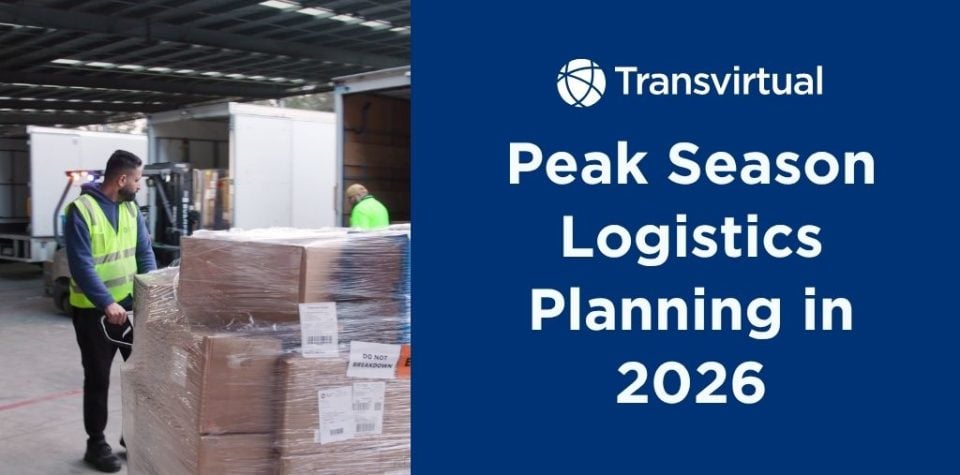Table of Contents
Year by year, logistics and transport providers prepare for the grind.
The peak logistics seasons arrive, and supply chains everywhere start to feel the pressure. Freight rates rise, capacity constraints tighten, and everyone scrambles to secure space before it’s too late.
If 2025 taught us anything, it’s that planning ahead is key. With high demand, port congestion, and shipping delays across global supply chains, logistics teams need proactive strategies to keep goods moving. The right technology also makes all the difference but we’re getting ahead of ourselves.
Let’s look at how to prepare your supply chain for 2026’s peak periods without losing sleep or shipments.
Understanding Peak Seasons and Their Impact
Peak season hits at different times globally.
For some, it’s the holiday rush, when shipping demand skyrockets as families reunite and retailers push to meet customer expectations. For others, it’s when many factories shut down for national holidays or restock for the next year season, tightening supply and driving higher costs across transport networks.
During these months, the sheer volume of goods moving through major ports can lead to port congestion, delivery delays, and potential shipping disruptions. Carriers introduce peak season surcharges to manage demand, while freight transportation rates and air freight prices climb due to limited space and reduced workforce availability.
What are the Key Peak Season Dates Around the World?

Understanding when peak periods happen globally allows logistics teams to plan ahead and minimise disruptions. Some of the most important peak logistics seasons 2026 include:
January: Lunar New Year / Spring Festival (China, Asia)
Factory shutdowns and holiday closures create shipping delays, making alternative shipping routes essential.March: Ramadan / Eid (Middle East, Southeast Asia)
High demand for seasonal goods and increased last mile logistics pressure.June: Mid-Year Sales (Global Retail)
Sudden demand surges for electronics, apparel, and promotional products. Freight rates may rise due to limited space.August: Back-to-School / Seasonal Change
Surge in shipping demand for school supplies and clothing. Port congestion is likely.November: Black Friday / Singles’ Day (Global eCommerce)
Massive high demand periods that push freight transportation rates higher.December: Christmas and Holiday Season (Global)
The most intense holiday period, with labor shortages, peak season surcharges, and the need for careful last mile logistics planning.
Managing Supply Chains and Holiday Season Logistics
The holiday season is the ultimate test for logistics teams. Between factory shutdowns, peak season surcharges, and a reduced workforce, even small disruptions can drive delivery delays. To navigate the holiday rush effectively, we recommend the following tips:
Plan inventory carefully
Use historical data and demand forecasts to avoid overstock or stockouts.
Prepare for high demand periods and anticipate potential shipping disruptions.
Optimize shipping routes
Consider alternative ports or transportation modes like air freight when major ports are congested.
Focus on last mile logistics to ensure parcels reach customers on time.
Coordinate with partners
Keep suppliers, freight forwarders, and carriers in the loop.
Strong relationships help secure capacity when it’s most limited.
Leverage technology
Software like Transvirtual’s Transport Management System offers automation tools for transport providers.
Track shipments, monitor inventory levels, and respond quickly to changing conditions.
By combining careful planning, smart routing, and real-time insights, teams can handle the holiday rush with fewer delays and maintain high service levels.

Post-Holiday Review and Continuous Improvement
Once peak season ends, it’s time to learn from what worked and what didn’t. A quick review ensures your supply chain is stronger for the next high-demand period:
Check deliveries: Analyse shipping delays and identify which transportation modes performed best.
Review inventory: Prevent overstocking and fine-tune production schedules.
Strengthen partnerships: keep suppliers and freight forwarders in the loop for future capacity access.
Leverage data: Review insights from operations to identify areas for improvement.
A fast post-season review keeps your operations ready, responsive, and efficient for the next peak.
Looking Ahead: Staying Ready for Peak Seasons
The peak logistics seasons of 2026 will challenge supply chains with high demand, limited capacity, and potential shipping disruptions. Preparing now is what separates smooth operations from costly delays.
Key takeaways to move forward:
Plan early: Mark key dates, secure space with shipping companies, and review inventory levels.
Anticipate disruptions: Consider alternative shipping routes, ports, and transportation modes to avoid bottlenecks.
Monitor performance: Track freight transportation rates, delivery delays, and operational capacity for continuous improvement.
Strengthen networks: Keep suppliers and logistics partners informed to ensure priority access during peak periods.
By taking these steps, businesses can reduce lost sales, manage peak season surcharges, and handle the holiday rush more effectively. Using data-driven insights and real-time visibility tools like those offered by Transvirtual can help teams stay one step ahead without disrupting daily operations.

